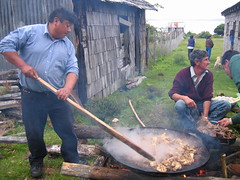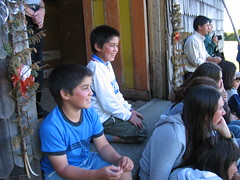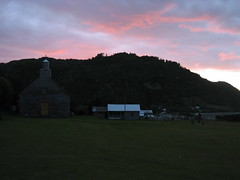Missions in Chiloé
17 January 2007
4:35 PM
This January I spent 10 days in Agony, but it was actually quite pleasant. On Jan. 2, I took a bus south with 100 high school students from Saint George on their annual missions trip. Once we had arrived in Chiloé, a sixteen-hour trip south from Santiago, we split into four groups to visit four separate communities. The luck of the draw landed me in a small community in the town of Agoní.
Despite the name, my first impression upon arriving was that the town was breathtakingly beautiful. The rural school where we stayed was abutted by steep green hills to the north and a beach to the south. Across the uneven green soccer field in front of the school was an old wooden chapel—Chiloé is famous for its wooden churches, especially the cathedral in Castro—with a giant door. If this is agony, I thought, I could spend some time here. Life on Chiloé is somewhat removed from civilization. And my destination within Chiloé was not one of the highly trafficked areas of this remote island, but a tiny town on the edge of nowhere. The town has a store the size of an RV. Around a hundred people live in the town. Their houses are divided between the beach and the rolling hills. From the tops of the hills on a clear day, you can see snow-capped volcanoes in the distance. Most of the residents work the land, raising livestock and Chilote potatoes, or the salmon farms.
The purpose of these mission trips, which I wrote about at length last year, is something called re-evangelization. The idea is to help people build Christian communities and reaffirm their faith. Before our arrival we were somewhat concerned because we heard that fighting between two groups in the community and the pastor left the church closed and inoperative for two years. Ultimately, we needn’t have worried. The people in the community received us warmly, in fact so much so at times that it was downright humbling.

One morning I arrived with three other students at María Hidalga’s house for the second time and she invited us to stay for lunch. We accepted and within a few minutes she had peeled 20 potatoes. Fantastic, I thought. I love potatoes. Before I knew what was happening, María walked outside and came back inside holding a chicken by its feet. The intermediate steps are something of a blur—hot water, feathers, knife sharpening—but 95 minutes later I was eating the chicken. Later I found that it was one of the eight hens she had.
Hospitality like that is something of a marvel in the modern world, and it wasn’t an isolated incident. Nearly everywhere we went we were invited to lunch, breakfast, coffee, or tea, whatever the time of day called for. At the end of our ten days with the community they threw a barbecue that featured the largest barbecue pit I had ever seen. The grill master stirred the pile of meat with what resembled a two-by-four.

I saw the dynamic of small, rural communities in other ways during my visit. Everyone knew everyone else’s stories. It was sometimes obvious that there were two distinct groups within the community; many times I would hear a person glorified in one house and vilified in the next. People seemed to have little free time; every spare moment was filled with caring for animals, cutting firewood for the wood-burning stoves, cooking, cleaning, planting potatoes and harvesting them. I also saw another perspective: the reliance on the land that seems like an oppressive burden to me was self-sufficiency that people there called liberating. I visited three men who lived alone—one had only a handful of visitors in the last decade—and the lack of other people to interact with struck me as almost unbearable. Even people who lived together in families had limited interaction outside a small circle.
Just like last year we filled the days with plenty of activities. We visited people in their houses during the morning, had activities for children in the afternoons, celebrated Mass in the evening, and held a youth group at night. Before long, ten days had passed and we left to make out trek back to Santiago.
See a slideshow of pictures from my trip to Chiloé and Agoní on Flickr.

Comments